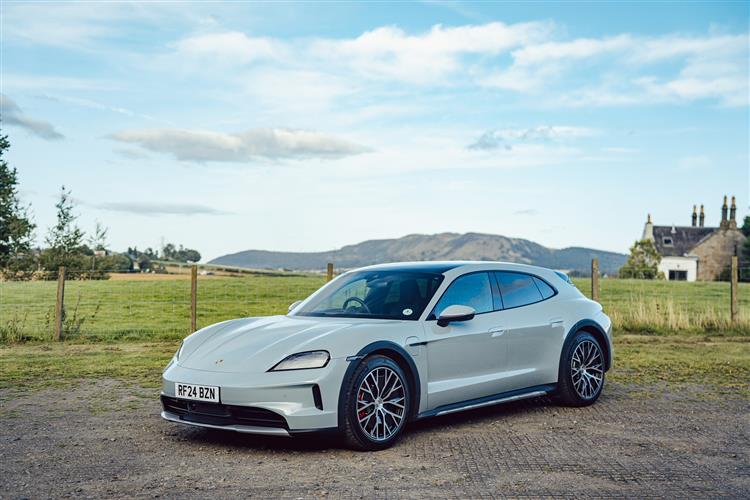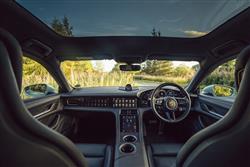PORSCHE'S CROSS PURPOSES (some text hidden) --NONE--
By Jonathan Crouch
Porsche's Taycan Cross Turismo is arguably the market's wildest electric SUV. Jonathan Crouch takes a look at the revised version.
Ten Second Reviewword count: 67
From launch, Porsche's first fully battery-powered model, the Taycan Sports Saloon, was billed as the company's first all-electric sports car. Can a sportscar also be an SUV? Porsche's insisting that it can - and to prove the point, in 2021 brought us this Taycan spin-off model, the Taycan Cross Turismo. Before substantially updating it in early 2024 to create the car we're going to look at here.
Backgroundword count: 169
Porsche has now long been a company as much about SUVs as sportscars. So it's natural that the brand's EV development should reflect that. The eye watering level of investment required means that it needs to anyway. Which is why the Taycan range was broadened in 2021 to include this crossover body style, available in both Sport Turismo guise and in this more SUV-like 'Cross Turismo' form. It might look like something from a Spielberg film and a car that can't quite make up its mind what it wants to be - Porsche doesn't like calling it an 'estate'. But it's proved to be the most popular of the Taycan models and, a little surprisingly, does have a degree of (optional) prowess for limited use off a paved surface. The improved version of this model that we examine here looks much the same - and sits on the same J1 800v platform as before - but under the skin gets big changes in terms of drivetrain and charge capability.
Driving Experienceword count: 490
The Cross Turismo shares the same powertrain options as the normal Taycan Sport Saloon, save for the fact that it can't be ordered with rear wheel drive. Quite a lot's new with this revised model, though for the time being, Porsche has decided not to adopt a tri-motor drive system, like that used in a rival Maserati GranTurismo Folgore. Instead, Zuffenhausen has redesigned this Taycan's rear electric motor, which is 10.4kg lighter than it was in the original version of this model, but up to 108PS more powerful, depending on the variant you're looking at. As for EV range, well that's up substantially, helped by the 2024 model year's increase in battery size for the standard larger 'Performance Battery Plus' pack, now rated at 105kWh. Total power output is considerably higher across the range than it was with the original Cross Turismo. When fitted with the Sport Chrono Pack that most customers want and with launch control engaged, the base Taycan 4S Cross Turismo now offers up to 598PS (68PS more than before). Which means that 62mph with launch control is dispatched in just 3.8s en route to 149mph. And that's at the bottom of the line-up. As for the Turbo variants, the strangely-named 'Turbo' version offers 884PS (203PS more than the original model) and the fiery Turbo S develops an impressive 952PS (188PS more than before). What else? Well air suspension is now mandatory (the old coil-spring set-up's no longer offered) and the twin-chamber air springs are matched to the new dual-valve dampers introduced in the current Panamera. This more greatly varies the car's behaviour between its 'Comfort' and 'Sport' modes and allows for variable ride heights at high speeds. As before, the most difficult task the engineers had here was in disguising what as usual on an EV is a prodigious kerb weight - in this case around 2.3-tonnes. Plenty's been thrown at that problem as part of this update. Optional is an Active air suspension system which enables individual control of each damper via a small electrically-driven compressor. Roll and pitch through the bends can then be countered, without the need for the physical anti-roll bars used in the previously-available PDCC anti-roll system. Turbo and Turbo S models get Porsche's Torque Vectoring Plus rear differential, which through turns is able to over-speed the outer rear wheel to help the Taycan's cornering balance. Rear-wheel steering is optional across the line-up (and standard on the GTS and Turbo variants). And all of this tech is co-ordinated by a clever Porsche 4D Chassis Control set-up. Does it go off road? Absolutely. The now-standard 'Off Road Design Package' adds an extra 'gravel' drive mode and an extra 10mm of ride height, so you can make assertive progress down the kind of light, unpaved roads that would damage an ordinary Taycan. You'll unsettle your passengers if you do that though; there's no 'comfort'-orientated 'chassis' mode and you can expect a firm feel.
To see the full road test text contact us on 0330 0020 227
Pictures (high res disabled)

.jpg)
|
.jpg)
|
.jpg)
| |||
.jpg)
|
.jpg)
|
.jpg)
| |||
.jpg)
|
.jpg)
|
.jpg)
| |||

|
Statistics (subset of data only)
Min |
Max |
|
Price: |
£99,200.00 (At 10 Apr 2025, Taycan 4S Cross Turismo) |
£165,500.00 (At 10 Apr 2025, Taycan Turbo S Cross Turismo) |
Insurance group 1-50: |
50 |
|
Max Speed (mph): |
149 (Taycan 4S) |
155 (Turbo S) |
0-62 mph (s): |
3.8 (Taycan 4S) |
2.5 (Turbo S) |
Electric WLTP-Rated Driving Range (miles): |
373 |
|
Length (mm): |
4974 |
|
Width (mm): |
1967 |
|
Height (mm): |
1409 |
|
Boot Capacity (l): |
446 |
|
Power (ps): |
598 (Taycan 4S) |
952 (Turbo S) |
Scoring (subset of scores)
Category: Hybrid, Plug-in, Electric & Hydrogen
| Performance | |
| Handling | |
| Comfort | |
| Space | |
| Styling, Build, Value, Equipment, Depreciation, Handling, Insurance and Total scores are available with our full data feed. | |



